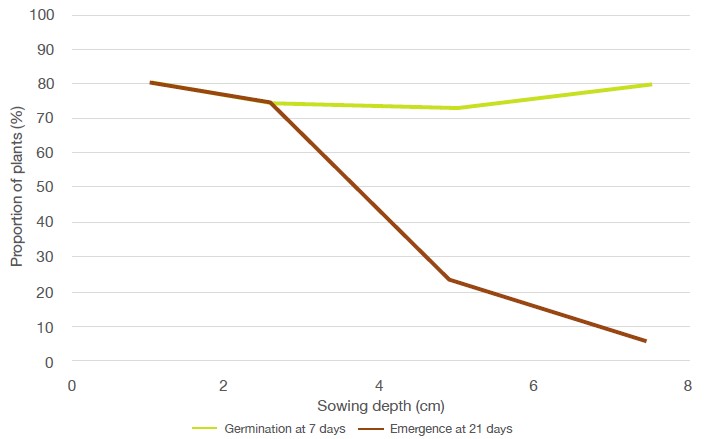- Home
- Knowledge library
- Grassland reseeding: sowing depth, seed rates and rolling
Grassland reseeding: sowing depth, seed rates and rolling
Find out about the specifics of achieving successful establishment and read our information on seed rates and rolling.
Back to: Establishing grassland reseeds
Sowing depth
Although seeds can germinate at any soil depth, a shallow sowing depth is critical for successful establishment. As the plant has limited energy stores in the seed, the seedling needs to reach the soil surface and start to produce leaf material in as short a time as possible before it runs out of energy.
For best results:
- Aim to sow seed within 1–2 cm of the soil surface
- For very small seeds, such as clover, a sowing depth of less than 1 cm is necessary to ensure emergence
At depths of 5 cm, only 20% of seedlings reach emergence three weeks after sowing (see graph below). In addition, of the seedlings that make it to the soil surface from this depth, they are much slower to tiller than those planted close to the soil surface.
Results of an experiment investigating the impact of sowing depth on the germination and emergence of plants

Seed rates
From the moment of sowing, which typically involves 15 to 25 million individual seeds per hectare, there is huge competition among seedlings.
In a good establishment, 15 to 25% of the seedlings that have germinated will survive the first three months. After a year, only 10 to 15% of plants tend to survive. A mature, stable sward typically has 300–400 plants per square metre.
Seed rates for grassland establishment vary from 18–35 kg/ha. Traditionally high seed rates have been used as an insurance policy to reduce the risk of weed infestation or compensate for poor emergence rates. These can occur because of uneven sowing depths, variation in seedbed quality or low soil moisture levels hindering germination.
Recent work from New Zealand has suggested that when ryegrass is sown at lower seed rates, such as 6–18 kg/ha, competition for resources such as light, soil and water is reduced. As a result, individual plants produce a greater number of tillers, generate more lateral roots and overall are larger.
Eight months after sowing, there was no difference in yield between high and low sowing rates. However, the long-term effects on persistency were not evaluated.
Typically, broadcasting seed can result in better ground cover of the sown species. However, in dry areas or on light soil, drilling into a prepared seedbed can ensure the seed is placed in contact with soil moisture. In these conditions, seed rates can be reduced by one-third.
Rolling
- Consolidation of the seedbed after drilling is extremely important as it helps to ensure good seed-to-soil contact, reduces water loss and may help control pest issues
- Around 50% of respondents who took part in the 2016 AHDB reseeding survey used a Cambridge roll and 46% used a flat roll, with the remainder using both. Over 40% of respondents rolled the field more than once
Useful links
Watch our webinar on getting the best out of your autumn reseeds

